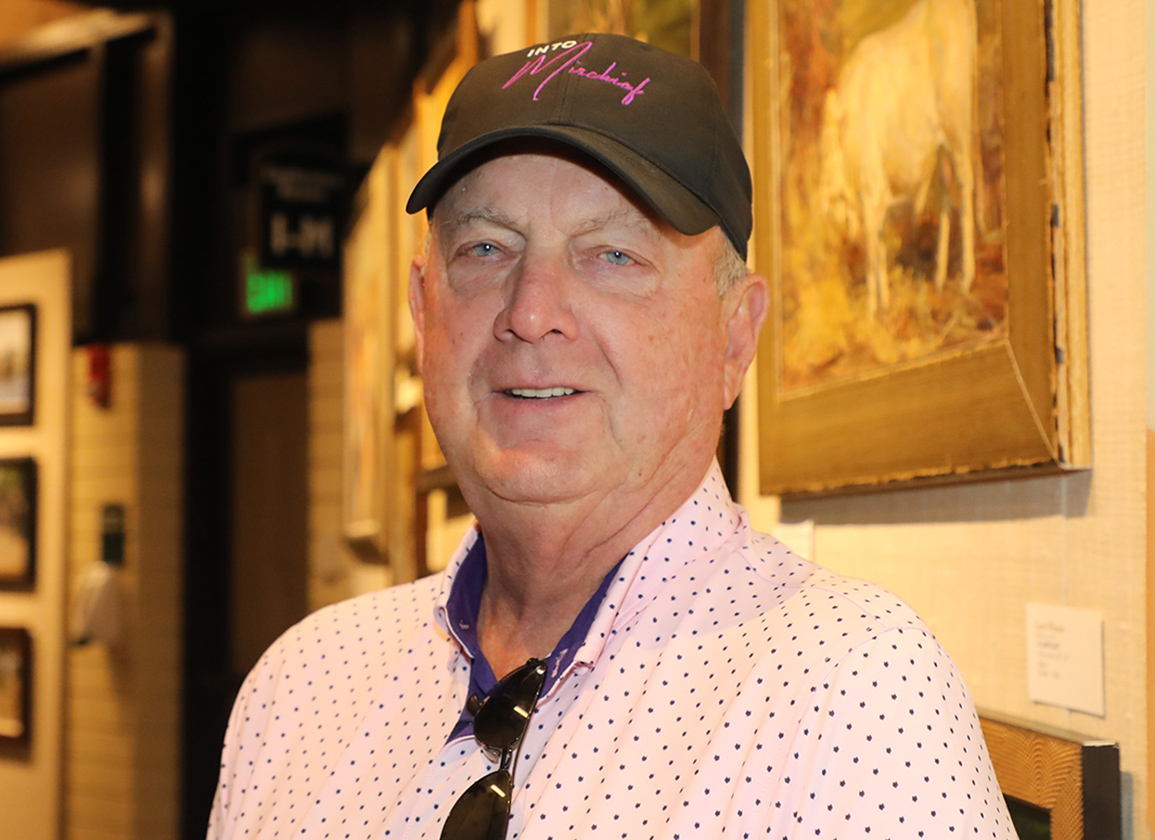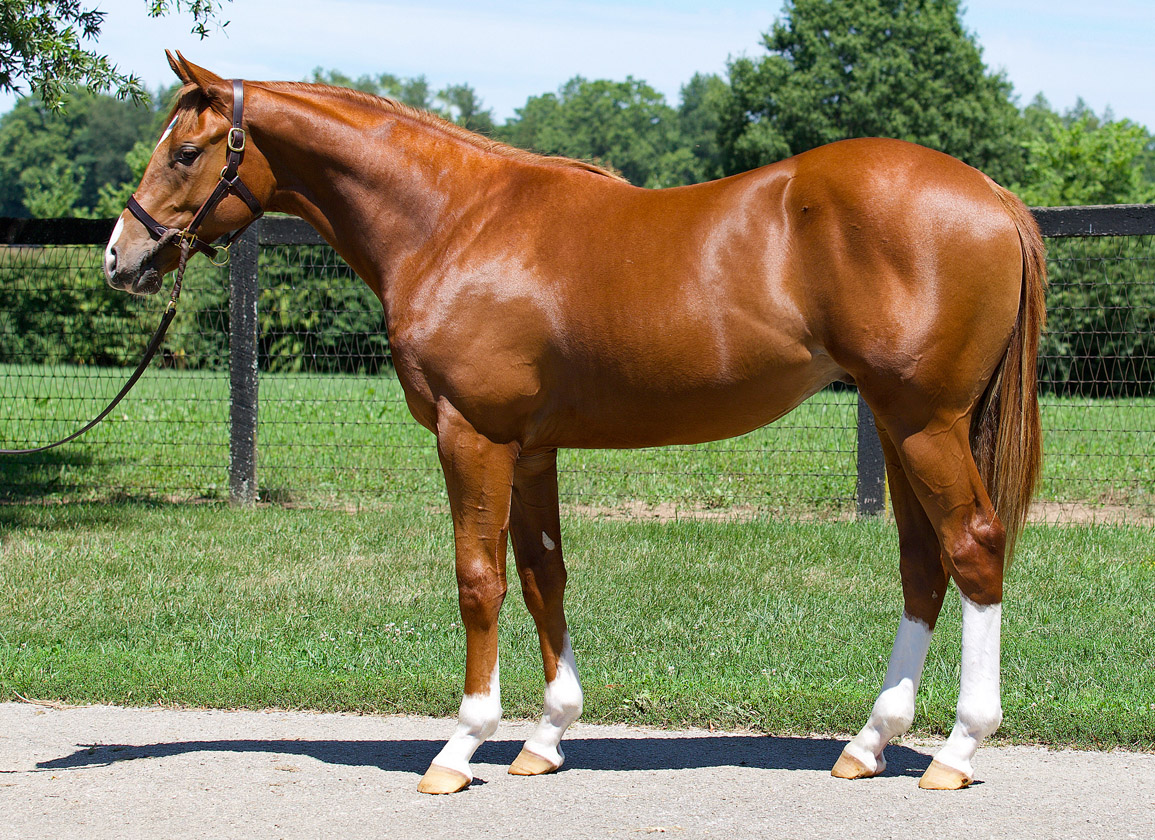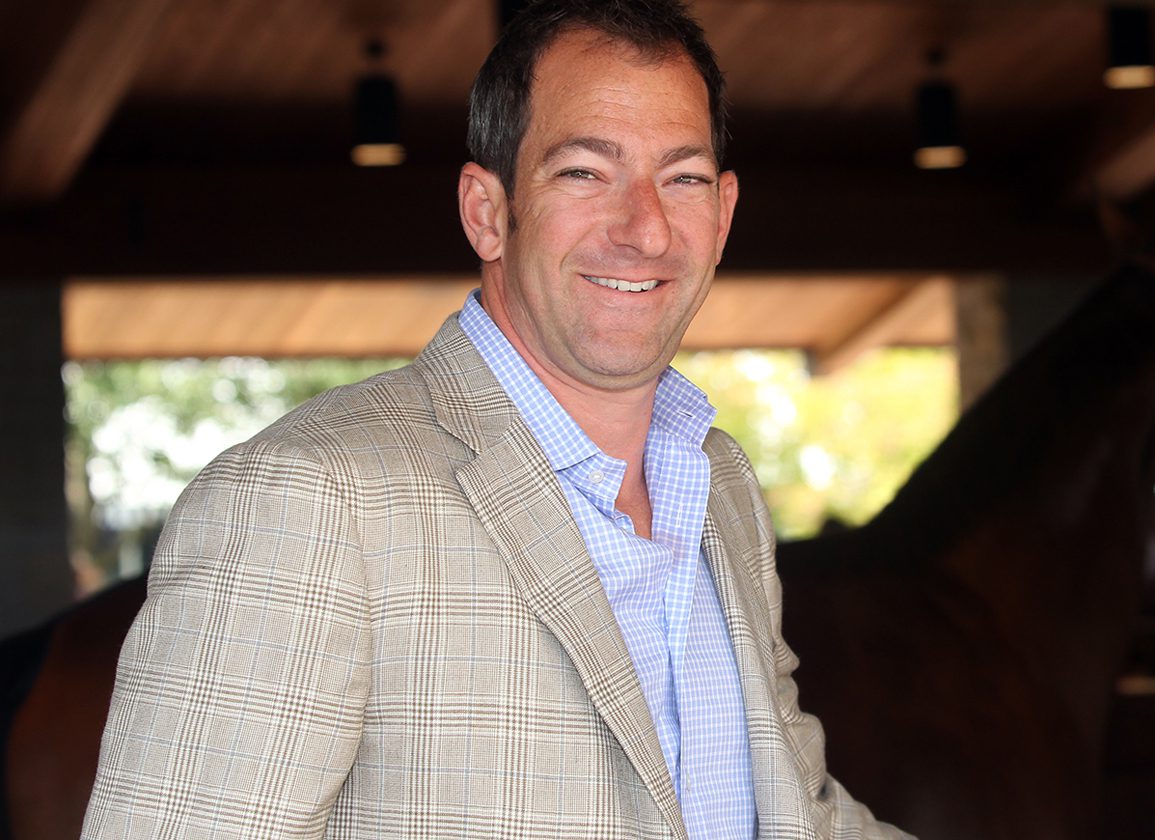Fred Hertrich III, along with partners John Fielding and Rob Tribbett, celebrated an exceptional year after their breeding program produced six Grade I winners in 2021: Americanrevolution (Constitution), Beyond Brilliant (Twirling Candy), Hit The Road (More Than Ready), Juju's Map (Liam's Map), Maxim Rate (Exchange Rate) and Pinehurst (Twirling Candy).
Such an achievement has led to many asking Hertrich the warranted question, 'What's your secret?'
He doesn't have one good answer other than this: “There's no magic to it, but there is a secret sauce and that sauce is luck,” he said. “Think of all the people involved in getting a horse to the winner's circle for a Grade I. One day we counted it up and guessed that 60 different individuals were involved in the process from when the mare was bred and when she foaled through when the foal went through the sale, and then the foal can take varied paths based on where it's broken, who trains it and of course the jockey. All you have to have is one glitch in that entire process and that horse may never even get to the track.”
Hertrich said he enjoys the in-depth strategic project that comes with drawing up mating plans for his commercial breeding operation each year. With over 100 mares visiting the breeding shed this year, the process is far from a one-day task.
Before breeding season begins each year, Hertrich will sit down with a panel that includes partner John Fielding, partner/advisor Rob Tribbett and Shane Doyle, the farm manager for Hertrich's Watercress Farm who Hertrich refers to as the conformation expert of the group.
As the panel makes plans for their young mares, Hertrich said their number one goal is to get winners on the mare's progeny record early in her career.
“They have to produce a horse that can run so that everyone can look and say that mare is a great producer,” he explained. “If a mare can't produce runners, it really doesn't matter how well her foals sell.”
According to Hertrich, this approach doesn't necessarily mean that an unproven mare will always visit a proven stallion.
“We do some analytics with it and while you're trying to get a runner, it may be that a first-crop sire conformationally and genetically fits that mare better than anything else. For the six Grade I winners we had, they are by five different stallions. It's not an exact science and that's why the guy with the most money doesn't always win.”
When evaluating mares that have already produced runners, he said it comes down to the balancing act of producing a horse that will have commercial appeal but can also conceivably have success on the track.
“It becomes an economic decision as to how do we maximize value of the foals from that particular mare with a mating that will give us the individual that will produce the best results,” he said. “We always lean toward [a focus on] race performance.”
Hertrich's strategy is perhaps atypical for many commercial breeders pointing their foals for the sales.
“There are some guys who just breed commercially and they're always trying to get Miss America into the yearling ring,” he explained. “That's great, except can Miss America go out and run? If she doesn't, you're only going to trick the market for so long.”

Fred Hertrich | Keeneland
Hertrich acknowledged that his program does have the luxury of not always needing to have progeny by the flavor-of-the-month sire to have success at the sales because many people seek out horses coming from his operation.
“The great thing is that over time, because of the results owners and trainers have had with us, we have built-in clients who come to the farm and want to buy from us because they know how we raise a horse and care for a horse, so they want to be involved in that process.”
While Hertrich always has his eye on the long game in this business, he acknowledges the high risk involved in the game he plays, citing how just last week they had a dystocia with one mare and ended up losing the foal but then had two healthy fillies on the ground three hours later.
“When someone says they want to go into the breeding business, I always tell them to make sure they really look at it before they get into it,” he said. “The breeding business is not for the faint of heart. How many great horses either are never foaled or get injured? It's a high-risk game.”
Hertich passed the baton to advisor and partner Rob Tribbett to discuss mating plans for a few of their top mares.
ALWAYS AUDITIONING (m, 16, Mizzen Mast – Nawal (FR), by Homme de Loi (Ire)) to be bred to Catholic Boy
Always Auditioning is the dam of GIISW Ready to Act (More Than Ready). This year we are booking her to Catholic Boy. He's a horse that we are obviously a bit biased on because we bred him, but we're big believers in him with not only the speed that he showed but also his determination and versatility. There aren't many stallion that have done what he's done on the track. This mating will produce a three-quarters sibling to Ready to Act, who of course is by More Than Ready.
BRAZEN PERSUASION (m, 11, Indian Charlie – Beholden, by Cat Thief) to be bred to McKinzie
This mare was a recent purchase of ours at the November Sale last year. She was a really good 2-year-old. She won the 2013 GIII Schuylerville S.
We are going to breed her to McKinzie, who is a horse that we really like because he was brilliant at two as a Grade I winner, but he was also durable enough to be a Grade I winner at three and four. We also love that McKinzie's dam, Runway Model (Petionville), won the GII Alcibiades S. We love to breed to those stallions that have a pedigree full of brilliance. I like this mating a lot because you're taking the brilliance of the mare, who was such a good 2-year-old, and putting it with a lot of speed from both McKinzie and his dam.
CATCH MY EYE (m, 13, Unbridled's Song – Sharp Eyes, by Storm Cat) to be bred to Curlin
This is the dam of GISW Maxim Rate (Exchange Rate). She's by Unbridled's Song, who we know is one of the best broodmare sires out there.
This year we are sending her to Curlin. Maxim Rate is a turf filly, but with matching this mare's pedigree to Curlin, we think it's a chance to produce that successful Classic-type runner. We think it's certainly within this mare's range of ability and Curlin is obviously one of the best stallions out there when it comes to getting that type of horse.
HOT CHA (m, 7, Bernardini – Hot Water, by Medaglia d'Oro) to be bred to Not This Time
Hot Cha is a young Bernardini mare that is from the family of champion Xtra Heat (Dixieland Heat). Again, I love mares that have speed in their family and there aren't too many fillies faster than Xtra Heat. This mare is a half to Hot and Sultry (Speightster), who just won really impressively at Oaklawn.
We are going to breed her to Not This Time. We think that the start he's gotten at stud with a lower stud fee was really impressive and is the mark of a stallion who could end up being a top-tier stallion after succeeding with those mares bred on a lower stud fee. As he gets these better books, I think the sky is really the limit for him.
LUNAR EMPRESS (m, 9, Malibu Moon – Holy Princess, by Holy Bull) to be bred to Liam's Map
This mare is from a really good family of stakes producers and she was very talented on the racetrack herself. She was a maiden special weight winner at Santa Anita and was fourth in the GI La Brea S. She's by Malibu Moon, who is another good broodmare sire.
We are going to breed her to Liam's Map, the sire of GISW Juju's Map that we bred in 2019. We're trying to raise runners; that's our main goal and then the commercial thing comes after that. Liam's Map certainly gives you a chance to have a great runner and they're going to be commercially-appealing horses as well.
MISS ARRANGEMENT (m, 11, Mr. Greeley – Shy Greeting (Arg), by Shy Tom) to be bred to Honor A.P.
Miss Arrangement was a maiden special weight winner on debut at Keeneland and she already had a yearling sell at Saratoga for $400,000.
We are going to breed her to Honor A.P. He's a horse that we have a lot of confidence in. He was such a talented horse and the win he had over Authentic in the GI Santa Anita Derby was really an impressive race. Like McKinzie, he's out of a top-class race mare which I think is such an added benefit when you're looking at a stallion prospect.

Nagambie's 2021 Audible filly that topped Book 5 of the Keeneland November Sale | photo courtesy Rob Tribbett
MO MUSIC (m, 4, Uncle Mo – Harmony Lodge, by Hennessy) to be bred to Authentic
Mo Music is carrying her first foal by Street Sense now. She is out of Harmony Lodge, who was another filly with a lot of speed. It's a really great female family.
We will be sending her to Authentic. With the natural speed that Authentic had and the stamina he had to carry that speed, we think it is a great match with this mare because there's already so much speed and class coming from her family.
NAGAMBIE (m, 9, Flatter – Charming N Lovable, by Horse Chestnut (SAF)) to be bred to Gun Runner
This is the dam of GISW Juju's Map (Liam's Map). She is currently in foal to Not This Time, who is the brother of Juju's Map's sire. This year she will be going to Gun Runner. Other than maybe Uncle Mo, it's hard to recollect another horse that had such a good first crop. Gun Runner was such a good racehorse and there's really no holes to him as a sire.
POLLY FREEZE (m, 9, Super Saver – Elusive Gold, by Strike the Gold) to be bred to Constitution
This is the dam of Americanrevolution (Constitution), who won the 2021 GI Cigar Mile H., as well as Bold Journey (Hard Spun), who just ran second in the Gander S. on Saturday. Polly Freeze has a really good Collected 2-year-old filly that brought $210,000 as a yearling and she is currently in foal to Frosted. She's a mare that makes a really good foal and she's from a family of really good producers.
We're going to send her back to Constitution. Some people say that he's the next great stallion, but I would say he's already a great stallion with what he's done on these lower-priced books. That's the mark of what his sire did and what Into Mischief has done that makes them a breed-changing stallion when they can succeed with a variety of mares.

Bold Journey (Hard Spun), the half-brother to GISW Americanrevolution, recently ran second in a stakes at Aqueduct for Bill Mott | photo courtesy Rob Tribbett
SUMMER ON THE LAWN (m, 12, First Defence – Summer Exhibition, by Royal Academy) to be bred to Charlatan
This is the dam of GISW Beyond Brilliant (Twirling Candy). She is booked to Charlatan. We were fortunate to be a part of his racing career as owners. He had so much speed and an ability to carry that speed a distance. Beyond Brilliant also has speed that can carry on both surfaces and I certainly think Charlatan could produce dual-surface runners given his pedigree.
SWEET CAUSE (m, 7, Giant's Causeway – Sweetness 'n Light, by Distorted Humor)
We are big believers in Giant's Causeway mares and Sweet Cause is from the family of MGISW Ms. Eloise (Nasty and Bold). We love mares with that type of race filly in her pedigree.
She will be booked to Catalina Cruiser. He is a horse that we really like and his first crop looked the part, which really didn't surprise us much because he is a beautiful horse. He's a big horse but he had a lot of speed for a big horse. We are going to be supporting him heavily this year.
YEAR OF PROMISE (m, 9, Gio Ponti – Shandra Smiles, by Cahill Road) to be bred to Twirling Candy
This mare is a half-sister to two Grade I winners–She's a Tiger (Tale of the Cat) and Smiling Tiger (Hold That Tiger). This year she will be going to Twirling Candy. Of our Grade I winners in 2021, two of them were by Twirling Candy. When we bred those mares he stood for $20,000 and really the best is yet to come for him.
This mare has already had a More Than Ready and a Constitution and now she will have a Twirling Candy. When we breed these young mares, we love to give them shots with these types of stallions. If she's going to be a producer, these stallions will get her there. Twirling Candy is rightfully now at that stud fee range where he's proven that he belongs. The two Grade I winners that we produced were a dirt 2-year-old and a turf horse, so that's a pretty impressive display of versatility.
Let us know who you're breeding your mares to in 2022, and why. We will print a selection of your responses in TDN over the coming weeks. Please send details to: garyking@thetdn.com.

The post Mating Plans: Hertrich Seeking the Long Game in a Risky Game appeared first on TDN | Thoroughbred Daily News | Horse Racing News, Results and Video | Thoroughbred Breeding and Auctions.
Source of original post





